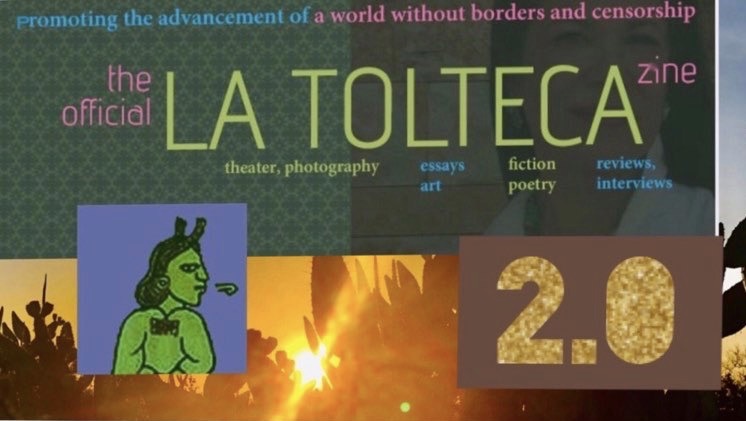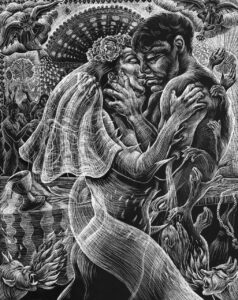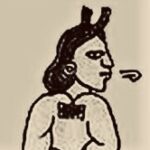La Tolteca 2.0: ¡Qué vivan los muertos!

La Tolteca 2.0 Issue #9 October 30, 2020
¡Qué vivan los muertos! Los Vivos ¡Presente! Our final issue of this La Tolteca 2.0 reprise edition is dedicated to the countless loss of human life the world have experienced this year. The pandemic took most, as have illness, social ills and the consequences of the planet’s suffering from climate change. We are a few days from the election results for the U.S. president. La Tolteca 2.0 will be on hiatus until February, 2020. Please come back and visit us here. We hope to have a subscription option by then. We hope there’ll be a COVID-19 vaccine available to all by then. We hope a new page in history has been turned. Most of all, we hope that you don’t give up hope.

You don’t have to be a Babe-Boomer or Brown to submit a selfie or fave pic of yourself: ana@anacastillo.net.

Artist Juana Alicia (Photo credit Ray Holbert) See some of la Maestra’s recent & past work in this issue.

Washington State based author Kathleen Alcalá, her Day of the Dead altar here.

Ed McCaughan (Photo Credit: John Kaine)

Paul McLennan is a long time grass roots organizer based in the State of Georgia. His reflections appear in this issue.

Juana Alicia: Maestra Artista
Featured artist in this issue is among the generation of muralists and printmaking that made history in San Francisco in the 1970s-80s Juana Alicia continues to produce her art in various forms. Since retiring from teaching in the Bay Area she lives in Merida, Yucatán, México.

MAESTRAPEACE, murals on The San Francisco Women’s Building, 18th and Valencia Streets, Juana Alicia, Edythe Boone, Miranda Bergman, Susan Cervantes, Meera Desai, Yvonne Littleton and Irene Perez, © 1994, 2000, 2010.
Artist Statement:
I work in diverse media to create both private and public works of art, including drawing, printmaking, small-format painting, monumental acrylic, fresco, tile and sculptural murals.  Many of my public works are in the Bay Area, as well as Pennsylvania, Mérida, Yucatán, Mexico and Managua, Nicaragua. Some of my works are individual and others are collaborative. I am a printmaker, illustrator and sculptor. I also seek to create architectonic and sculptural works in a cityscape with an increasingly green and sustainable global vision.
Many of my public works are in the Bay Area, as well as Pennsylvania, Mérida, Yucatán, Mexico and Managua, Nicaragua. Some of my works are individual and others are collaborative. I am a printmaker, illustrator and sculptor. I also seek to create architectonic and sculptural works in a cityscape with an increasingly green and sustainable global vision.
My work as an artist has frequently been inspired by literature, especially poetry. The voices of the women have often moved me to make images.
I work for the future, for my children and grandchildren and theirs.

I ASK NO FAVOR FOR MY SEX: ALL I ASK OF OUR BRETHREN IS THAT THEY TAKE THEIR FEET OFF OUR NECKS, Portrait of Ruth Bader Ginsburg, 16” x 20”, scratchboard, Juana Alicia ©2020 Printed by Thomas Wojak at The Works Atelier, Vallejo, CA *
Art and cultural work are means I use to work toward these goals as a citizen of the earth:
~An end to femicides and violence against women and LGBTQIA folk.~An end to war, whether that be internal or external to the country.
~Racial equality and an end to violence against indigenous communities.
~An ecological transformation that gets us off of fossil fuels and promotes a green economy, while respecting the rights of marginalized populations and the original inhabitants of the lands.

Complete installation of THE SPIRAL WORD: EL CODEX ESTANFOR, Stanford University’s El Centro Chicano murals, digital prints with watercolor on paper and acrylic paint on canvas, Juana Alicia ©2012 Installation and inspiration: Tirso Araiza
“Our intersectional movements must come together, creatively, politically, and spiritually for the very survival of the planet.

As artists, we can remove structures of oppression from our collective imagination and replace them with visions that celebrate our autonomy and power.” –Juana Alicia

Juana Alicia (by permission of the artist)
- RGB print purchase info:
The original went to Chicana collectors and I am currently selling the screen print edition at a special election season rate of $150 until next week. After that the price will go up significantly. I’ll be showing both pieces at my upcoming exhibit at the San Francisco Arts Commission Gallery, sometime during the next year and a half.) I’m taking prepayments for the prints now, and will notify everyone when it’s finished. The shipping charges will vary depending on the recipient’s location. ——-Abrazos, Juana Alicia (Email ana@anacastillo.net to have your request forwarded to the artist.)
Dias de Muertos
Kathleen Alcalá: State of Washington
Author of novels: Spirits of the Ordinary, Treasures in Heaven, The Flower in the Skull, a short story collection, Mrs. Vargas and the Dead Naturalist and The Desert Remembers My Name, essays.

Kathleen Alcalá’s Day of the Dead Altar (under construction, dedicated to the victims of Covid-19
Ed McCaughan: Oaxaca
Photography:
Ed McCaughan

Ed McCaughan (Photo Credit: John Kaine)
Emeritus Professor of Sociology, San Francisco State University
Author of Art and Social Movements: Cultural Politics in Mexico and Aztlan (Duke Univ. Press) .
Now residing in Oaxaca, México, Ed has taken these pictures there:



(Ed. note: The Days of the Dead begin on October 31st through November 2nd. On the 31st it is believed the souls of beloved children that had passed came to visit that night. Treats were left out for them.)

(Ed. Note: The flowers on Day of the Dead altars, grave sites and tombs are traditionally the cempasúchitl (a variety of the marigold) and Cresta de Gallo or cockscomb.

Cresta de gallo flor
Mexican indigenous ancestors believed the cempasúchitl had curative powers but over time have now lost them are now mostly decorative.)

Vivero en Colima, México (Photo credit: Rude Calderón)
A couple of weeks before Dia de Los Muertos many streets and corners come alive with vibrant orange cempasúchil flowers, as these viveros (nurseries) bring their colorful product to the streets. Colima is our second home and my wife’s hometown, I spend several months a year here. I was born in Costa Rica and raised in Los Angeles since the age of seven. The tropical climate and verdant landscapes of Colima remind me of my motherland!

Paul McLennan: Georgia
(personal essay)
I’ve really gone deeper in recent months on the question of settler colonialism. A new book I’ve recently read, Settler Colonialism, Race, and the Law by Georgia State University Law Professor Natsu Saito talks about how “racism can be meaningfully eliminated only in conjunction with decolonization.” I remembered Trump talking about the taking down of monuments and saying, “How far back are we going to go?”
Good question.
Like Canada, Australia, Israel, and South Africa, the United States was formed as a settler colony. With white supremacy as a guiding philosophy, the genocide of indigenous peoples, the labor of enslaved Africans, and the annexation of Mexican territory are at its foundation. Regardless of who wins the election on November 3rd, oppressed peoples will still have many struggles to wage against this exploitative and repressive system.
We all have visions of a better world but in Settler Colonialism, Race and the Law: Why Structural Racism Persists, Professor Saito, who is also a local organizer, urges us to “understand what’s wrong with where we are, and how it got to be wrong. Tracing the problems to its source allows us to conceive structural, rather than superficial, solutions.” She believes the pervasive problem of white supremacy can only be dealt with in combination with a movement of decolonization.
The people of Bolivia and Chile have recently given us reason to hope and are providing us lessons for how we might strategize to achieve that better, decolonized world. On October 18th, el Movimento al Socialismo (MAS)/Movement Toward Socialism party won a decisive victory electing Luis Arce as its president. This was Bolivia’s first elections since Evo Morales, Bolivia’s first indigenous president, was removed in a U.S. backed right-wing coup last fall. Arce served as economy minister for twelve years under Morales as poverty was sharply reduced and wealth and land more equitably redistributed.
A week later, on October 25th, the people of Chile voted overwhelmingly by 78.2% to draft a new constitution. This was a key demand of protestors who took to the streets last year in the largest civil unrest in decades. The current charter dates back to the dictatorship of Augusto Pinochet which began on September 11, 1973. This is a major step towards doing away with the pro-corporate practices that led to low wages, inadequate social services, and privatization. The peoples’ victories in Bolivia and Chile are a blow against the same kind of neoliberal and fascist policies we are witnessing in this county.
“I was very inspired by the work of Ella Baker and SNCC who believed in the power of ordinary people to empower themselves to make transformative change.”~ Paul McLennan

Photo credit: Zoe Seiiler
Regardless of who sits in the White House or on the Supreme Court, history shows us that by continuing to organize, protest, and marching in the street, we can move closer to that better world we imagine.
~

Paul McLennan
Paul McLennan is a retired member of the Amalgamated Transit Union Local 732 and on the board of the Beacon Hill Black Alliance for Human Rights, a local, Black-led organization based in Decatur, Georgia.
THANK YOU FOR CHECKING OUT THIS ISSUE. L/T. 2.0 WILL BE TAKING A HIATUS. WE’LL BE BACK FEBRUARY, 2021.

GUIDELINES:
Open submissions.
Except for La Tolteca 2.0 images all contributing images of art and photos are previously unpublished and credited.
LA TOLTECA 2.0 had made its return here at www.anacastillo.net It is a virtual zine with ongoing posts.
You may submit to ana@anacastillo.net
You’ll receive an automated response. (If you don’t receive the automated response alert me on FB messenger) For consideration to the following new features only unpublished, never posted on SM, original images and material.
New L/T 2.0 Features
BOX 4B: Brown & Beautiful Babe-Boomers
You don’t have to be brown or a Boomer and your submissions don’t have to be selfies to submit. Send us what gave you a smile, lifted your spirits, kept you going that past week. Smart phone pics work, no specific format necessary. Do NOT send images previously posted on social media or elsewhere. Your submission is consent for use at L/T 2.0. Add a couple of lines with your name and about the pic or yourself to be included, if selected. If any of your submission is selected it will be posted the following Friday. If not, you won’t hear from us but you will be welcome to send something new for consideration again.
Yo ¡Presente!
No rants or editorials, please. Only clean, proof-read submissions in a journalistic style will be read for consideration. Double space, 12 point, Times Roman—750 words. Your most recent activist concern. Include your name and a line describing how you participate in social justice issues. Checklist for your piece: What, when, why who and how.
Poetry. Flash Fiction, Memoir and Testimonio
Original and unpublished work. Spanish and English languages considered.
All submissions must have been proofread double-spaced, 12 point, paginated. Fiction word count limit 750. Your name and one line about yourself or your submission.
La Tolteca 2.0 is a blog. We reserve all rights to post as and what we choose.
If your original works appear here you may use again elsewhere with credit to first appearing at La Tolteca 2.0 (and date.)
Thank you for reading, feel free to share link and all positive vibe comments welcome. You don’t have to be brown and a babe boomer to submit but if you are, we are here for you. February, 2020 we return.



1 Comment
grace purpura November 07, 2020 - 00:58
Congratulations Ana Castillo on yet another beautiful and thoughtful Tolteca 2. Enjoyed seeing the powerful work of Juana Alicia and to know that Juana is still an active and very much a vital force. The color photographs of Ed McCaughan are fantastic, and the essay by Paul McLennan was thoughtful and well considered. Thank you for this lovely and enlightening issue. Have a good respite. We will be looking forward to the next issue.